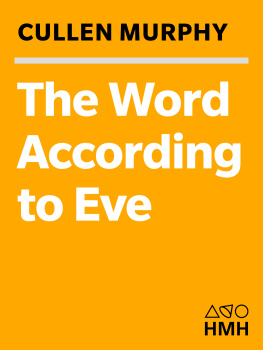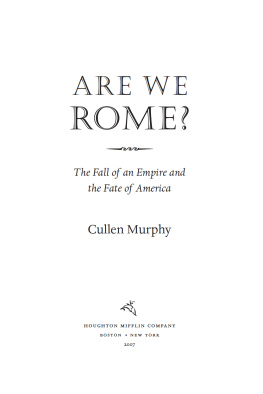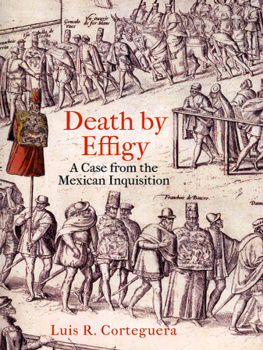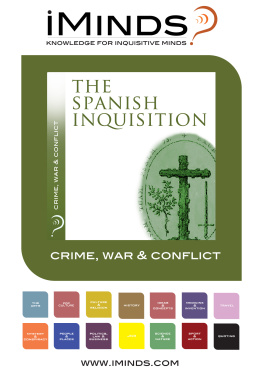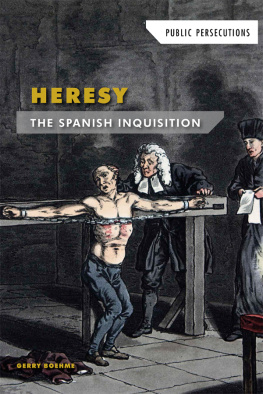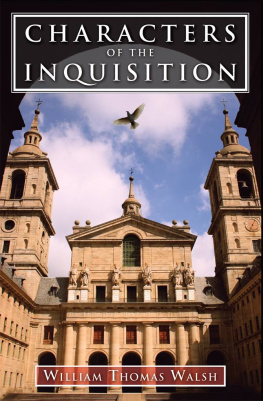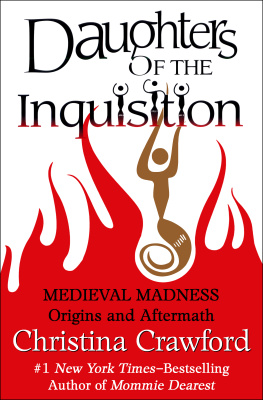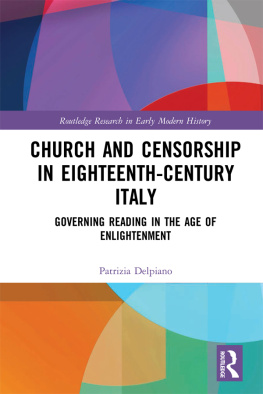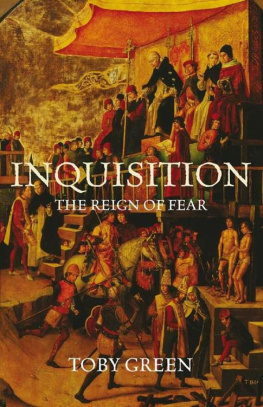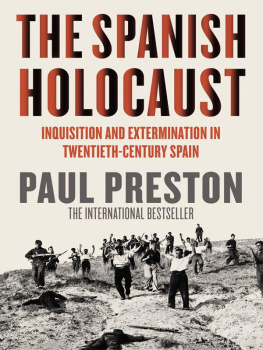
Table of Contents
Copyright 2012 by Cullen Murphy
All rights reserved
For information about permission to reproduce selections from this
book, write to Permissions, Houghton Mifflin Harcourt Publishing
Company, 215 Park Avenue South, New York, New York 10003.
www.hmhbooks.com
Library of Congress Cataloging-in-Publication Data
Murphy, Cullen.
Gods jury : the Inquisition and the making of the modern world / Cullen Murphy.
p. cm.
Includes bibliographical references and index.
ISBN 978-0-618-09156-0
1. Inquisition. I. Title.
BX 1713. M 87 2012
272'.2dc23
2011028599
Book design by Brian Moore
Printed in the United States of America
DOC 10 9 8 7 6 5 4 3 2 1
For A.M.T.
1. Standard Operating Procedure
The Paper Trail
No one goes in and nothing comes out.
A VATICAN ARCHIVIST, 1877
Theology, sir, is a fortress; no crack
in a fortress may be accounted small.
REVEREND HALE, THE CRUCIBLE, 1953
The Palace
O N A HOT FALL day in Rome not long ago, I crossed the vast expanse of St. Peters Square, paused momentarily in the shade beneath a curving flank of Berninis colonnade, and continued a little way beyond to a Swiss Guard standing impassively at a wrought-iron gate, the Porta Cavalleggeri. He examined my credentials, handed them back, and saluted smartly. I hadnt expected the grand gesture, and almost returned the salute instinctively, but then realized it was intended for a cardinal waddling into the Vatican from behind me.
Just inside the gate, at Piazza del SantUffizio 11, stands a Renaissance palazzo with the ruddy ocher-and-cream complexion of so many buildings in the city. This is the headquarters of the Congregation for the Doctrine of the Faith, whose job, in the words of the Apostolic Constitution, Pastor bonus, promulgated in 1988 by Pope John Paul II, is to promote and safeguard the doctrine on faith and morals throughout the Catholic world. Pastor bonus goes on: For this reason, everything which in any way touches such matter falls within its competence. It is an expansive charge. The CDF is one of nine Vatican congregations that together make up the administrative apparatus of the Holy See, but it dominates all the others. Every significant document or decision emanating from anywhere inside the Vatican must get a sign-off from the CDF.
The Congregation also generates plenty of rulings of its own. The Vaticans pronouncements during the past decade in opposition to cloning and same-sex marriage originated in the CDF. So did the directive ordering Catholic parishes not to give the names of past or present congregants to the Genealogical Society of Utah, a move that reflects the Vaticans grave reservations about the Mormon practice of posthumous baptism. The declaration Dominus Jesus, issued in 2000, which reiterated that the Catholic Church is the only true church of Christ and the only assured means of salvation, is a CDF document. Because the Congregation is responsible for clerical discipline, its actionsand inactionsare central to the pedophilia scandals that have shaken the Catholic Church. For more than two decades, the Congregation for the Doctrine of the Faith was headed by Cardinal Josef Ratzinger, now Pope Benedict XVI, who during his long reign as prefect was known as the enforcer and sometimes as the Panzerkardinalbane of liberals, scourge of dissidents, and bulwark of orthodoxy narrowly construed. The Congregation has been around for a very long time, although until the Second Vatican Council it was called something else: the Congregation of the Holy Office. From the lips of old Vatican hands and Church functionaries everywhere, one still hears shorthand references to the Holy Office, much as one hears Whitehall, Foggy Bottom, or the Kremlin.
But before the Congregation became the Holy Office, it went by yet another name: as late as 1908, it was known as the Sacred Congregation of the Holy Roman and Universal Inquisition. Lenny Bruce once joked that there was only one the Church. The Sacred Congregation of the Universal Inquisition was the headquarters of the Inquisitionthe centuries-long effort by the Church to deal with its perceived enemies, within and without, by whatever means necessary, including some very brutal ones. For understandable reasons, no one at the Vatican these days refers to the Congregation as the Inquisition except ironically. The members of the papal curia are famously tone-deaf when it comes to public relationsthese are men who in recent years have invited a Holocaust-denying bishop to return to the Church, have tried to persuade Africans that the use of condoms will make the AIDS crisis worse, and have told the indigenous peoples of Latin America that their religious beliefs are a step backward but even the curia came to appreciate that the term had outlived its usefulness, although it took a few centuries.
Its easy to change a name, not so easy to engage in genetic engineering (which the Church would not encourage in any case). The CDF grew organically out of the Inquisition, and the modern office cannot escape the imprint. Ratzinger, when he was still a cardinal, was sometimes referred to as the grand inquisitor. New Yorks John Cardinal OConnor once introduced the visiting Ratzinger that way from a pulpit in Manhattana not entirely successful way to break the ice. The epithet may have originated in the fevered minds of some progressive Catholics, as a Ratzinger fan site on the Web explains, but it became widespread nonetheless. (In response to a Frequently Asked Question, the same site offers: Good grief. No, Virginia, Cardinal Ratzinger was not a Nazi.)
The palazzo that today houses the Congregation was originally built to lodge the Inquisition when the papacy, in 1542, amid the onslaught of Protestantism and other forms of heresy, decided that the Churchs intermittent and far-flung inquisitorial investigations, which had commenced during the Middle Ages, needed to be brought under some sort of centralized controla spiritual Department of Homeland Security, as it were. Pope Paul III considered this task so urgent that for several years construction on the basilica of St. Peters was suspended and the laborers diverted, so that work could be completed on the palace of the Inquisition. At one time the palazzo held not only clerical offices but also prison cells. Giordano Bruno, the philosopher and cosmologist, was confined for a period in this building, before being burned at the stake in Romes Campo dei Fiori, in 1600.
When I first set foot in the palazzo, a decade ago, it was somewhat shabby and ramshackle, like so much of Rome and, indeed, like more of the Vatican than one might imagine. Outside,Vespas tilted against kickstands. In a hallway beyond the courtyard, a hand-lettered sign pointed the way to an espresso machine. A telephone on the wall dated to the 1950s. Here and there, paint flaked from ceilings and furniture. But the Congregation has a Web site now, and e-mail, and a message from Piazza del SantUffizio 11 can still fray nerves in theology departments and diocesan chanceries around the world.
The Congregation for the Doctrine of the Faith inherited more than the Inquisitions institutional DNA and its place on the organizational charts. It also inherited much of the paper trail. The bulk of the Vaticans records are part of the so-called Archivio Segreto, and for the most part are stored in a vast underground bunker below a former observatory. (Segreto, though translated as secret, carries the connotation private or personal rather than classified.) But the Vaticans holdings are so greatthe indexes alone fill 35,000 volumesthat many records must be squirreled away elsewhere. The Inquisition records are kept mainly in the Palazzo del SantUffizio itself, and for four and a half centuriesup until 1998that archive was closed to outsiders.
Next page

